Cafe Sans Sodium
We had to start on a very low salt diet. It wasn’t something we thought we should try; we had to do it.
This post is about strategies to decrease salt intake. It is based on experiences in decreasing personal dietary salt and in teaching these concepts at the university level and to patients with cardiovascular and renal disease.
It comes down to this: less salt = longer and healthier life for the vast majority of people. Excess salt intake increases the risk of hypertension, stroke, heart attack, other cardiovascular disease, kidney function, stomach cancer, and osteoporosis. These diagnoses represent earlier death and greater disability before death (more ER visits, more hospitalizations, poorer quality of life, and so on).
Facts and figures
2300 mg salt = recommended daily intake for adults
3400 mg salt = average American daily intake.
2000 mg salt = one teaspoon of salt.
2000 mg salt = our maximum; we usually stay under 1000.
1049 mg salt = 4 ounces of deli turkey!
70% dietary salt intake in America is from processed foods.
Increased potassium dietary intake decreases salt sensitivity and favorably affects BP.
All the measurements are of sodium (Na), which is not the same as salt (NaCl). Many resources use the words interchangeably and so have I. Also, different resources give different food values. So it goes.
General concepts
Really, for most people, excess salt intake is like just another desire – just another bad habit. Salt is like a drug – and it works. It does make food taste better. Whatever. Cigarettes work too, and so do heroin and cocaine, I’m told. And of course alcohol works very well. It’s just that there are all these side effects…
In most cases, eating out means much greater salt intake. Restaurants, especially fast food restaurants nearly always add large amounts of salt to foods. In a later post I’ll note strategies for lower salt eating out. But so long Vietnamese, Thai, and Mexican restaurants. Sigh.
Get a digital scale. The Amazon Basics scale was $10.99 in 2018. For us, the scale improves our quality of life in that we know exactly how much salt we’re taking – and if someone wants a high salt food like aged cheese, just measure out an ounce (28 gm aged cheddar = 230 mg salt), split it, and savor it.
Savor what you have. Don’t worry about what you don’t have. Yes, the potatoes could use some salt. Keep chewing, keep tasting those potatoes. Enjoy what you have. The craving will pass. (Applies to other aspects of life.)
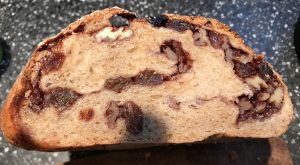
Sourdough with walnuts, currants, cinnamon, sugar – about 1/2 tsp salt/loaf = ~50 mg/slice
Read labels and use internet calculators. Salt and other contents vary according to brands and sources of information. Looking at several references shows trends and commonalities.
Low salt cooking isn’t just leaving out or decreasing the salt. It’s about finding other ways to ramp up the taste, adding spices or sauce for example. Indian food is great without salt. Thai can be done. Middle eastern can be tasty and very low salt (hope you like garlic; see note re za’atar). Even macaroni and cheese can be good (use gruyere and Swiss, don’t salt the water).
Some prepared foods brands are very salty, while some are not, e.g., the salt content of corn tortillas ranges from 180 mg/tortilla to 10 mg/tortilla! Bread is fairly high in salt and baking bread with less salt is a challenge as more salt = better taste.
Fish sauce – I-yi-yi-yi! One teaspoon = 443 mg sodium. Try using a teaspoon Worcestershire sauce (65 mg) or a quarter teaspoon of nuoc mam for taste.
——————
Some of what we’ve cooked and served here at the Cafe Sans Sodium: salad nicoise with swordfish; roasted chicken, Japanese sweet potato, sauteed chard with shallots; granola; potato, leek, onion soup with beet, persimmon, lettuce salad; fish tacos, grilled pork loin with garam masala rub, cilantro chutney, yogurt; grilled chicken – several variations; chicken soup, homemade with egg noodles; risotto with mushrooms, lebnah, salad with fennel; hummus and tabouli; pan-fried sole with homemade blackening spices; Thai food, including ginger chicken with onions, green curry, pork with garlic, black pepper, and onions, tom kha; lobster with baked potato and salad; omelet with lobster and gruyere; salad with herbs, leftover meat; meatloaf with baked potatoes, beet greens with shallots (with ketchup on top for total of 300 mg/serving); Goan shrimp curry; ratatouille with spaghetti squash, meatballs, frisee salad and mustard vinaigrette; stir-fry vegetables with tamarind sauce, grilled pork, tabouleh. Almost everything here <300 mg salt/serving.
——————-
Chicken enchiladas, 2 servings (160-180 mg/serving – salt amounts in parentheses)
6-8 ounces cooked chicken – enough to make four enchiladas (120 mg)
4 corn tortillas (40 mg)
1.5 oz gruyere cheese (240 mg for the gruyere we used [160 mg/ounce])
Enchilada sauce – homemade
Chopped onion and cilantro (0 mg)
Moisten tortillas with water and microwave ~15 seconds to soften
Make enchiladas: put a little enchilada sauce on tortilla, then chicken, then roll ‘em up in a small baking pan. When all are rolled, cover with enchilada sauce. Can top with cheese now or after baked.
Cover with cheese if not already. Top with onions.
Sorry about that prepared salsa with tons of salt – Tabasco is the way to go for more heat OR make your own.
You can make your own tostados, frying those 10 mg tortillas one at a time.
—————-
Salt in cheese – again, the key is to savor small amounts of this wonderful food, which, as everyone knows, lies close to the top of the Berkeley Food Pyramid (http://berkeleyfoodpyramid.com/). All values are for 28 gm/1 ounce.
Lebneh* <40 mg
Swiss 40-55 mg
Gruyere 95-120 mg
Goat cheese 40-146 mg
Monterey jack 153 mg
Mozzarella 178 mg
Aged cheddar 210-240 mg
Provolone 250 mg
Feta 316 mg
Parmesan 433 mg (1 tablespoon grated = 61 mg, enough for some taste)
*Homemade from full fat yogurt
Homemade lebneh (or lebnah or labnah)
Line a basket with ~ 4 layers of cheesecloth. Pour in a pint or quart of full fat yogurt. The tangier the yogurt, the better. Let the yogurt drain for about 24 hours, pouring the whey off periodically. You can also put the yogurt in a muslin bag, hang the bag from faucet, and just let it drain into the sink. At the end of 24 hours you’ll have lebneh. I think you lose about half the bulk of the yogurt.
Things to use in place of salt (not necessarily salt substitutes)
Mrs. Dash
Za’atar (Sadaf brand green zaatar from Mid-eastern store. This stuff is a real treasure.)
Za’atar, homemade
Dill seed
Tabasco, Sriracha
Fresh chilis, thin sliced
Pickled onions, radishes (pickle in vinegar, no salt)
Spicier, tangier food in general.
Always 3-4 sauces or condiments on the table.
Tamarind sauce (Jean’s invention – helps you get past the lack of fish sauce): 1:1:1 Lemon juice, lime juice, tamarind concentrate (liquid, not paste). The 1:1:1 proportions are just a starting point.
There is a commercial potassium (K+) available as a salt substitute. I haven’t heard anyone say they like it, but I’m sure we’ll give it a try.
Middle Eastern Salad
1-2 ounces homemade lebneh (40-80 mg)
1 ounce goat cheese (146 mg)
Tarragon leaves (0 mg)
Dill or fennel fronds (0)
Mint leaves
Lettuce
Pickled onions (red onions sliced thin, covered in vinegar with a little sugar)
Cherry tomatoes
Sliced cucumbers
Olive oil or vinaigrette
Za’atar
Flat bread, toasted lightly
Pile cheeses in center of plate; cover with herbs and lettuce; arrange onions, tomatoes, cucumbers, and grilled chicken.
Za’atar recipe
- 2 tablespoons minced fresh thyme
- 2 tablespoons sesame seeds, toasted
- 2 teaspoons ground sumac*
- 1/2 teaspoon coarse salt
Thai dishes that work with just a touch of fish sauce (<180/serving) include pork with garlic and black pepper, curry made from homemade curry paste (with a food processor it isn’t hard), and tom kha. We’ll keep exploring this.
Pork with garlic and black pepper (2 servings)
8-10 ounces pork (not totally lean), cut into thin strips
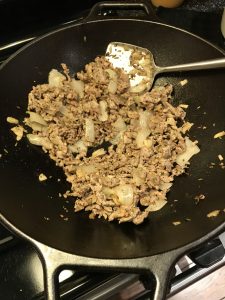
Pork with garlic and black pepper
1/8 cup cilantro stems
8-10 garlic cloves, cut into thin slices
1 tsp sesame oil1/4 tsp fish sauce
Juice from 1 juicy lime or 2 less juicy ones
½ tsp sugar
Lots of medium-coarse grind black pepperMedium size onion cut into ¼” – ½” wide strips
Tomato cut in ~ 3/4“ pieces
peanut oil
Make a paste of the cilantro, garlic, sesame oil, fish sauce, lime juice, sugar.
Mix and (using the spine of a chef’s knife) pound this into the pork slices and marinate at least an hour.
Fry the pork in a tablespoon of oil in a very hot wok or skillet for 5-10 minutes until the marinade is cooked off and the meat is done. Add onion and tomato and fry for a few more minutes. At the end it’s good if the meat is browned and has some crispy edges.
Serve with steamed rice and salad made of cucumber, red onion or shallots, and chillis in vinegar with about one teaspoon or so sugar (however sweet you like it).
References
Farquhar, et al. (2015). Dietary sodium and health: more than just blood pressure. Journal of the American College of Cardiology 65(10), pp. 1042-1050.
US Centers for Disease Control and Prevention. (2017). Sodium and dietary guidelines. Online: https://www.cdc.gov/salt/pdfs/sodium_dietary_guidelines.pdf
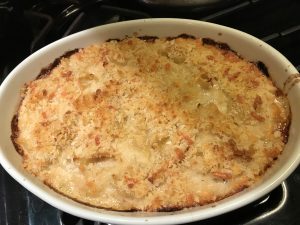
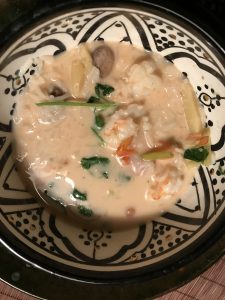
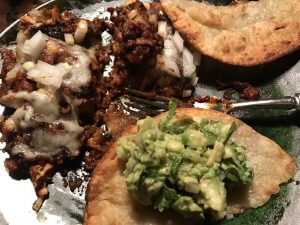
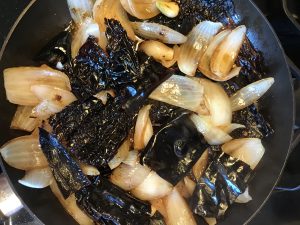
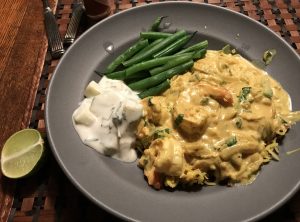
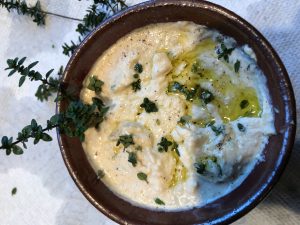
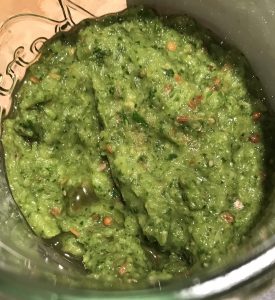
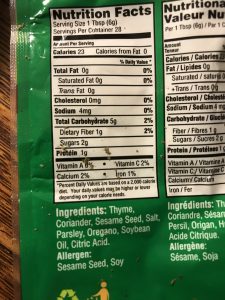
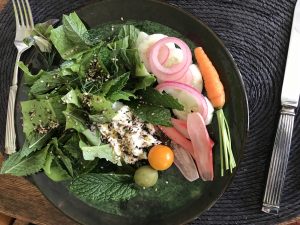
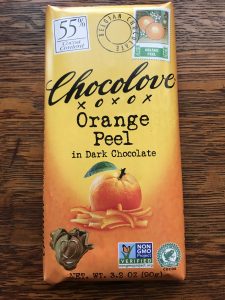
Perfect timing. We’ve been grappling with this issue too lately with a few screw-ups!
Thanks a million! Lots of good ideas!